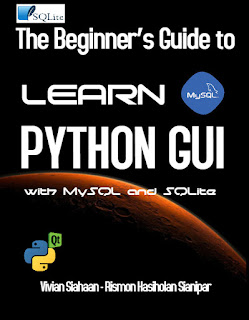 This book
explains relational theory in practice, and demonstrates through two projects
how you can apply it to your use of MySQL and SQLite databases. This book
covers the important requirements of teaching databases with a practical and
progressive perspective. This book offers the straightforward, practical
answers you need to help you do your job. This hands-on
tutorial/reference/guide to MySQL and SQLite is not only perfect for students
and beginners, but it also works for experienced developers who aren't getting
the most from both databases. In designing a GUI and as an IDE, you will make
use Qt Designer.
This book
explains relational theory in practice, and demonstrates through two projects
how you can apply it to your use of MySQL and SQLite databases. This book
covers the important requirements of teaching databases with a practical and
progressive perspective. This book offers the straightforward, practical
answers you need to help you do your job. This hands-on
tutorial/reference/guide to MySQL and SQLite is not only perfect for students
and beginners, but it also works for experienced developers who aren't getting
the most from both databases. In designing a GUI and as an IDE, you will make
use Qt Designer.
In the first chapter, you will
learn to use several widgets in PyQt5: Display a welcome message; Use the Radio
Button widget; Grouping radio buttons; Displays options in the form of a check
box; and Display two groups of check boxes.
In chapter two, you will learn to
use the following topics: Using Signal / Slot Editor; Copy and place text from
one Line Edit widget to another; Convert data types and make a simple
calculator; Use the Spin Box widget; Use scrollbars and sliders; Using the
Widget List; Select a number of list items from one Widget List and display
them on another Widget List widget; Add items to the Widget List; Perform
operations on the Widget List; Use the Combo Box widget; Displays data selected
by the user from the Calendar Widget; Creating a hotel reservation application;
and Display tabular data using Table Widgets.
In chapter three, you will learn:
How to create the initial three tables project in the School database: Teacher,
Class, and Subject tables; How to create database configuration files; How to
create a Python GUI for inserting and editing tables; How to create a Python GUI
to join and query the three tables.
In chapter four, you will learn how
to: Create a main form to connect all forms; Create a project will add three
more tables to the school database: Student, Parent, and Tuition tables; Create
a Python GUI for inserting and editing tables; Create a Python GUI to join and
query over the three tables.
In chapter five, you will join the
six classes, Teacher, TClass, Subject, Student, Parent, and Tuition and make
queries over those tables.
In chapter six, you will create dan
configure database. In this chapter, you will create Suspect table in crime
database. This table has eleven columns: suspect_id (primary key),
suspect_name, birth_date, case_date, report_date, suspect_ status, arrest_date,
mother_name, address, telephone, and photo. You will also create GUI to
display, edit, insert, and delete for this table.
In chapter seven, you will create a
table with the name Feature_Extraction, which has eight columns: feature_id
(primary key), suspect_id (foreign key), feature1, feature2, feature3,
feature4, feature5, and feature6. The six fields (except keys) will have
VARBINARY(MAX) data type. You will also create GUI to display, edit, insert,
and delete for this table.
In chapter eight, you will create
two tables, Police and Investigator. The Police table has six columns:
police_id (primary key), province, city, address, telephone, and photo. The
Investigator table has eight columns: investigator_id (primary key),
investigator_name, rank, birth_date, gender, address, telephone, and photo. You
will also create GUI to display, edit, insert, and delete for both tables.
In the last chapter, you will create two tables, Victim and Case_File. The Victim table has nine columns: victim_id (primary key), victim_name, crime_type, birth_date, crime_date, gender, address, telephone, and photo. The Case_File table has seven columns: case_file_id (primary key), suspect_id (foreign key), police_id (foreign key), investigator_id (foreign key), victim_id (foreign key), status, and description. You will create GUI to display, edit, insert, and delete for both tables.


No comments:
Post a Comment